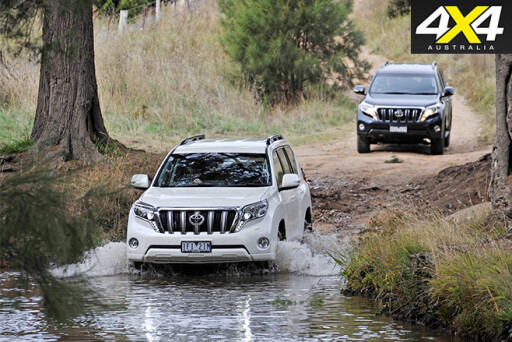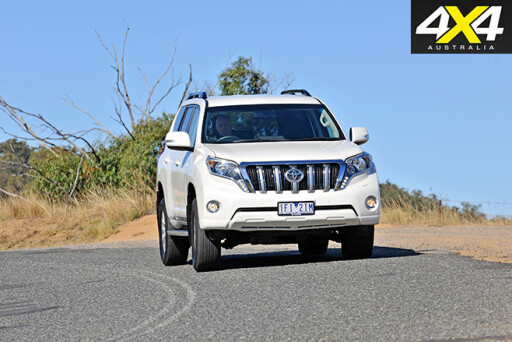
NOT ALL Prados are mechanically identical, and that’s not just due to the difference between diesel and petrol engines, or the availability of a manual gearbox with the diesel. More expensive VX and Kakadu models come with Toyota’s Kinetic Dynamic Suspension System (KDSS), a feature not fitted to, or available with, the GX and GXL models.
For on-road driving, KDSS lessens body roll for flatter and sportier handling, yet it also provides more wheel travel for superior performance in rough off-road terrain. It does this by automatically adjusting the tension on the suspension’s sway bars (also called anti-roll bars).
The trouble is: the cheapest way to get KDSS is on the $73,990 VX. That’s a $12,000 ask over the best-selling GXL auto – the closest non-KDSS Prado to a VX. However, you get more than just the KDSS when you step up to a VX from the GXL (see VX Upgrades breakout).
While we have driven every spec-level Prado, from GX to Kakadu, we have never had the chance to compare a non-KDSS Prado against a KDSS-equipped Prado to see the difference KDSS makes. To this end, we have lined up a GLX and a VX.
 We chose the VX over the more expensive Kakadu due to the Kakadu having features such as height-adjustable rear suspension and variable dampers that would throw unwanted variables into the mix. We also chose a GXL auto, as the VX is auto-only. The only variable we couldn’t control is that the GXL comes with 17s, while the VX runs with 18s.
We chose the VX over the more expensive Kakadu due to the Kakadu having features such as height-adjustable rear suspension and variable dampers that would throw unwanted variables into the mix. We also chose a GXL auto, as the VX is auto-only. The only variable we couldn’t control is that the GXL comes with 17s, while the VX runs with 18s.
THE THEORY
TO UNDERSTAND KDSS it’s best to start with what a sway bar is and what it does. In essence, a sway bar is just a torsion-bar spring that connects opposite wheels across either axle. It increases the suspension’s roll stiffness independent of spring rate, so it provides flatter handing without unduly compromising ride quality.
A sway bar isn’t a necessary part of a suspension system, and for an off-road vehicle where wheel travel is paramount, it’s not what you want.
The first-generation Range Rover (1970), the 4x4 that pioneered all-coil, long-travel, live-axle suspension, wasn’t fitted with sway bars for most of its quarter-century-long production life. The end result was extremely supple long-travel suspension that worked brilliantly off-road. However, there was a fair degree of body roll when driven hard through corners and, as more and more people bought their Range Rovers purely for on-road use, there was public demand for a flatter-handing vehicle, which was achieved by fitting sway bars. Unfortunately this also diminished the Range Rover’s legendary off-road ability.
This compromise between off-road wheel travel and on-road handing is, of course, one of the classic design dilemmas of a modern 4x4 that’s expected to perform well both on- and off-road.
 One solution is to manually ‘disconnect’ the sway bar(s) for off-road use and then reconnect it for on-road use. Up-spec variants of Nissan’s GQ Patrol have a mechanical release for the rear sway bar operated via a lever in the cab, while the Jeep Wrangler Rubicon has an electro-mechanical release for the front sway bar operated via a dashboard switch.
One solution is to manually ‘disconnect’ the sway bar(s) for off-road use and then reconnect it for on-road use. Up-spec variants of Nissan’s GQ Patrol have a mechanical release for the rear sway bar operated via a lever in the cab, while the Jeep Wrangler Rubicon has an electro-mechanical release for the front sway bar operated via a dashboard switch.
The other solution is to have some means to vary the tension on the sway bars – softer for off-road; firmer for on-road – which is exactly what KDSS does.
With KDSS, one end of each sway bar is connected to the chassis via an hydraulic cylinder, rather than being directly attached to the chassis. These two cylinders, one at the front and one at the rear, are then connected via hydraulic lines that allow an exchange of hydraulic fluid between the two.
When the vehicle is cornering on-road and tries to lean over, the pressure from the front and rear cylinders is cancelled out, which doesn’t allow an exchange of fluid between the two. With the ends of the sway bars locked solid, the sway bars then have to twist – as they do in a conventional suspension – to suppress body roll.
In an off-road situation, where rough ground will have the wheels on one side of the vehicle travelling in opposite directions, fluid can flow between the two cylinders. This relaxes the sway bars for greater wheel travel. On the Prado’s rear axle, KDSS increases wheel travel from 465mm to 565mm (more than 20 per cent).
 The other benefit of being able to relax the sway bar for off-road use is that a stiffer sway bar can be employed in the first place on the VX, which leads to flatter on-road handing.
The other benefit of being able to relax the sway bar for off-road use is that a stiffer sway bar can be employed in the first place on the VX, which leads to flatter on-road handing.
KDSS, as fitted to the Prado, has some minor electronic control on what is otherwise a simple hydro-mechanical system. The first-generation KDSS, as fitted to the Land Cruiser 200, is purely hydro-mechanical with no electronic override.
KDSS came about after Toyota purchased the rights to Kinetic Suspension Technology, a Western Australian company specialising in off-road suspension.
THE RESULT
SO, HOW well does it work? Surprisingly well, in fact. And while we have always been aware of the difference KDSS makes, it was illuminating to drive these two back to back.
Jumping from the GXL to the VX on-road, you could instantly feel the flatter handing, the shaper turn-in and the better body control. The VX is also noticeable smoother when entering corners and when transitioning from leaning over to an upright stance. The KDSS-equipped VX is a noticeably crisper and sportier on-road drive than the non-KDSS GXL. Some of the benefit here comes from the VX’s 18s, but the critical difference, namely the reduced sidewall height, is only in the order of eight per cent, so it’s not a significant amount.
 Off-road, especially in broken and rough ground, the VX feels suppler and is certainly more capable with all the extra travel. In mud and sand, where travel isn’t so much the issue, the benefit lessens.
Off-road, especially in broken and rough ground, the VX feels suppler and is certainly more capable with all the extra travel. In mud and sand, where travel isn’t so much the issue, the benefit lessens.
The sad part of this tale is the price hike from a GXL auto ($61,990) to the VX ($73,990). However, you do get plenty of worthwhile kit with the VX – unlike the more expensive Kakadu, which includes add-ons with little value.
It’s just a shame KDSS isn’t fitted to the popular GXL, or at least offered as an option on the Land Cruiser 200 GXL diesel.
VX UPGRADES
IF YOU go for a Prado VX over a Prado GXL, you get 18-inch alloys (instead of 17s); leather trim; heated front and second-row seats; electric seat and steering wheel adjustment; power-fold third row seating; auto headlights and wipers; a 17-speaker premium audio system; front parking sensors; and, of course, KDSS.
LAND ROVER’S ACE
LAND Rover’s Discovery II (1998) offered ‘active’ sway bars, called Active Cornering Enhancement (ACE), on some models. ACE used a high-volume, high-pressure pump and hydraulic rams, placed between the chassis and the sway bars, to tension or relax the sway bars depending on whether the vehicle was travelling straight or around a corner.
When travelling straight, the hydraulic rams placed no resistance on the ends of the rollbars, which gave the effect of not having a rollbar at all. Once the vehicle entered a corner the hydraulic rams tensioned the sway bars by an amount proportional to the vehicle’s lateral acceleration, as measured by two accelerometers. In essence, ACE is a more complex (pump-driven) version of Toyota’s KDSS system. It came out nearly 10 years before KDSS first appeared on the then-new Land Cruiser 200, in 2007.
NISSAN’S HBMC
CLOSER to the original Kinetic Suspension Technology (developed in Western Australia), is Nissan’s Hydraulic Body Motion Control (HBMC), as used on the Y62 Patrol.
This fully independent suspension system does away with mechanical sway bars by using interlinked, active dampers. By pumping hydraulic fluid from one side of the vehicle to the other – managed by electronically controlled, nitrogen-charged accumulators – the suspension travel can be adjusted to limit body roll when cornering on-road, or maximise the wheel travel for off-road use. The system works brilliantly.
PRICES
Prado GXL (auto): $61,990*
Prado VX: $73,990*
*Prices do not include on-road costs.
[specs]
TOYOTA PRADO 2.8D
Engine: DOHC 16-valve 4-cyl turbo-diesel
Capacity: 2.8-litre (2755cc)
Power: 130kW @ 3400rpm
Torque: 450Nm @ 1600-2400rpm
Gearbox: six-speed auto
4x4 system: full-time dual-range
Crawl ratio: 36.1:1
Construction: separate chassis
Front suspension: independent/coils
Rear suspension: live axle/coils
GXL wheel/tyre spec: 265/65R17 112S
VX wheel/tyre spec: 265/60R18 110H
Kerb mass (full range): 2150kg-2435kg
GVM: 2900kg
Payload (full range): 465kg-750kg
Towing capacity: 2500kg
Seating capacity: seven
Fuel tank capacity: 150 litres
ADR fuel claim: 8.0L/100km
On-test consumption: 10.4L/100km
Touring range*: 1392km
*Based on test consumption and 50km ‘safety margin’.

COMMENTS